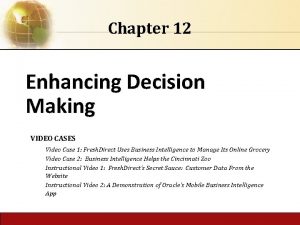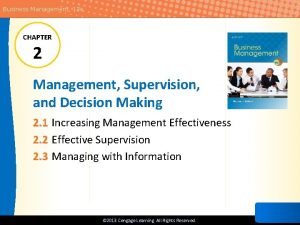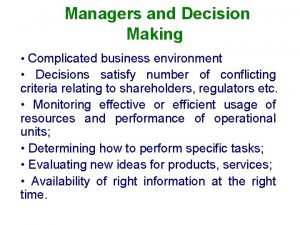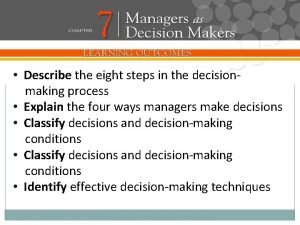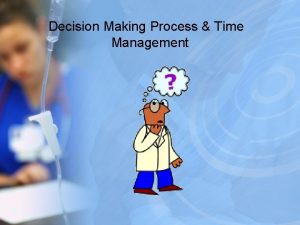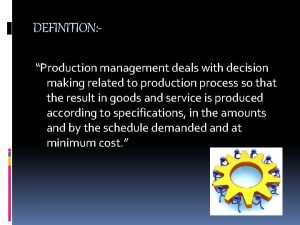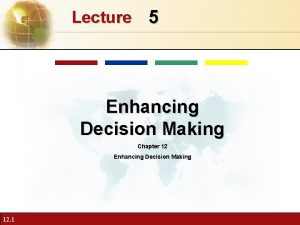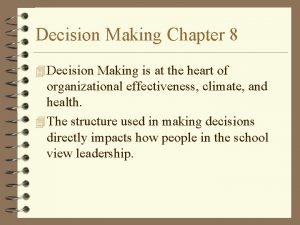Enhancing Management Decision Making Chapter 12 What is



















- Slides: 19

Enhancing Management Decision Making Chapter 12

What is a decision-support system (DSS)? • A DSS assists management decision making by combining data, sophisticated analytical models, and user-friendly software into a single powerful system that can support semi-structured or unstructured decision making. • These systems help end users utilize data and models to discuss and decide semi-structured and unstructured problems, but they do not solve the problems for the user.

Difference between DSS &MIS Dimension MIS • Provides structured Philosophy • Provides integrated tools, data, info to end users. models and language to users. • Enhances control and Objective • Directly impacts key decisions and enhances effectiveness of monitoring power of managers. decision making. Control Systems Design DSS • Under end-user control of • data, tools and sessions. • Establishes what tools are • used in the decision process. • Iterative prototyping process • during development Largely dominated by IS professionals. Identify info. requirements. Gathers requirements then freezes system.

How can DSS support unstructured or semistructured decision making • Unstructured problems are novel, non-routine and have no predefined algorithms or solutions. • DSS combine data with models to produce various alternative scenarios that can be used for making choices. • In large organizations, decision making is inherently a group process, and DSS can be designed to facilitate group decision making.

What is the difference between a datadriven DSS and a model-driven DSS? • A model-driven DSS has a model at its heart, perhaps a mathematical or spreadsheet representation of such a model. • The emphasis is on the model, scenarios, and what-if sensitivity such as linear programming. • A data-driven DSS analyzes great amounts of data to find information or patterns about information buried in the data. • These on-line analytical processing systems analyze data in different ways than traditional databases with an emphasis on multidimensional queries. • Examples of the data-driven DSS include Wal-Mart’s data warehouse and American Express’, Bank of America’s, and Sears’ datamining systems. • The Voyage management is an example of a model driven system. The system used by Rosenbluth is a hybrid of data and model driven DSS.

What are three basic components of a DSS? • DSS database: a collection of current or historical data from a number of applications or groups, organized for each access by a range of applications. The DSS database is separated from active organizational data, but contains data extracted from corporate databases. • Model base: a collection of mathematical and analytical models that can be made easily accessible to the DSS user. Various kinds of models may be in the model base, including libraries of statistical, optimization, sensitivity analysis ("what if"), and forecasting models. • DSS software: permits easy interaction between users and the DSS database and model base and delivers the end-user interface.

What is a customer decision-support system? How can the Internet be used for this purpose? • A customer decision-support system (CDSS) supports the decisions of customers of the organization. • Examples of such systems are discussed in the Window on Organizations. • The Bond Network and student answers to the Window question should answer this question as well.

What is a group decision-support system (GDSS)? How does it differ from a DSS? • A GDSS is an interactive computer-based system to facilitate the solution of unstructured problems by a set of decision makers working together as a group. • They have been developed in response to the growing concern over the quality and effectiveness of meetings. • DSS support primarily unstructured and semi-structured management decision making of various types. • GDSS are one type of DSS that focuses on supporting decision making by a group.

What are three underlying problems in group decision making that have led to the development of GDSS? The three underlying problems in group decision making that led to the development of GDSS are: • The explosion of the number of decision maker meetings (managers spending 35 to 70 percent of their time in meetings). • The growing length of decision maker meetings. • The increased number of attendees at these meetings--optimal size of traditional meetings is only three to five participants. •

Describe three elements of a GDSS The three elements of a GDSS are: • Hardware: including the conference facility itself, the room, tables, chairs, the layout of the facility, electronic hardware, audiovisual equipment, and computer hardware; • Software tools: including tools for organizing ideas, gathering information, and ranking and prioritizing; • People: including participants, a trained facilitator, and hardware and software support staff.

GDSS software tools Many tools exist. • Electronic questionnaires: aid the organizers in pre-meeting planning by identifying issues of concern and by helping to insure that key planning information is not overlooked. • Electronic brainstorming tools: allow individuals simultaneously and anonymously to contribute ideas on the topics of the meeting. • Idea organizers: facilitate the organized integration and synthesis of ideas generated during brainstorming. • Questionnaire tools: support the facilitators and group leaders as they gather information before and during the prioritization process.

GDSS software tools • Voting or prioritizing tools: make available a range of methods of prioritizing and decision making, from simple voting, to ranking in order, to a range of weighted prioritizing and voting techniques. • Stakeholder identification and analysis tools: use structured approaches to evaluate the impact of an emerging proposal upon the organization, and to identify stakeholders and evaluate the potential impact of those stakeholders upon the proposed project. • Policy formation tools: provide structured support for developing agreement on the wording of policy statements. • Group dictionaries: document group agreement on definitions of words and terms central to the project. • Additional tools might include: group outlining and writing tools, software that stores and reads project files and software that allows the attendees to view internal operational data stored by the organization's production computer systems.

What is an electronic meeting system (EMS) • An EMS is a type of collaborative GDSS that uses information technology to make group meetings more productive by facilitating communications as well as decision making. • It supports any activity where people come together, whether at the same place and time or in different places or at different times.

How GDSS can address the problems in group decision making • The explosion of the number of decision maker meetings: GDSS addresses this problem by making meetings more effective through improved pre-planning, increased participation, a more collaborative atmosphere, criticism-free idea generation, evaluation objectivity, and improved idea organization and evaluation. In addition, the number of meetings can be reduced by the preservation of "organizational memory" once the meeting is completed, making the information from the meeting available both to attendees and relevant non-attendees.

How GDSS can address the problems in group decision making • The growing length of decision maker meetings: GDSS addresses this problem in two major ways--simultaneous, electronic input rather than round-robin input, and improved planning and organization of meetings. • The increased number of attendees at these meetings: essentially all aspects of GDSS address this problem. Simultaneous, electronic input is central to a solution, but so are such elements as open, collaborative meeting atmosphere, criticism-free idea generation, evaluation objectivity, all of which make better use of the individuals who do attend.

Define and describe the capabilities of an executive support system • Executive support systems (ESS) help managers make unstructured and semi-structured decisions. • They focus on the information needs of senior management and combine data from both internal and external sources. • A system is a generalized computing and communications environment that can be focused on a changing array of problems. • ESS include tools for modeling and analysis.

How can the Internet be used to enhance executive support systems? • There are several ways that the Internet and Web technology can enhance such a system. • First, the Web interface is a well known and understood interface, making it easier to use and less costly to create the interface. • Secondly, the Web is an important source of data and information

In what ways is building executive support systems different from building traditional MIS systems? • Building ESS is different in a number of ways from building traditional MIS. • ESS are built through prototyping rather than the traditional structured methods because executive needs change so rapidly. • More preparation is done in advance with MIS systems before the user is included because executives expect quick results and they expect success the first time. • Once the user is involved, development must be very rapid to satisfy executives, far more so than with MIS systems. • This often means purchasing and learning the software prior to working with the executive. • Finally, at first ESS systems will be given far greater support per user than with traditional MIS systems--IS departments often make the system available to very few people, perhaps two to six, while assigning one or two people to full-time support. • This way they can iron out wrinkles rapidly enough to prevent the failure of the project.

What are the benefits of ESS? How do these systems enhance managerial decision making? Benefits of ESS are not easily measured. Nonetheless scholars have identified a number: • ESS flexibility allows executives to shape the problems, using the system as an extension of their own thinking. • ESS offer executives the ability to analyze quickly and to compare and highlight trends, freeing up executives--and even more so, their staffs--for more creative analysis and decision making. • ESS can and do change the workings of organizations. Executives are better able to monitor activities below them, allowing them to push decision making further down in the organization while expanding the executive's span of control.
 Enhancing decision making
Enhancing decision making Enhancing decision making
Enhancing decision making Objectives of decision making
Objectives of decision making Slidetodoc.com
Slidetodoc.com Management chapter 5 planning and decision making
Management chapter 5 planning and decision making Chapter 2 management supervision and decision making
Chapter 2 management supervision and decision making Management chapter 5 planning and decision making
Management chapter 5 planning and decision making What is mis in computer
What is mis in computer Types of decision making in management
Types of decision making in management Decision making tools in management ppt
Decision making tools in management ppt Eight steps in decision making process
Eight steps in decision making process Decision making process definition
Decision making process definition Management deals with
Management deals with Short-term decision making
Short-term decision making Strategic management decision making process
Strategic management decision making process What is the essence of decision making
What is the essence of decision making Chapter 6 prices and decision making assessment answers
Chapter 6 prices and decision making assessment answers Steps in decision making
Steps in decision making Chapter 2 economic systems and decision making
Chapter 2 economic systems and decision making Financial decision-making process
Financial decision-making process

